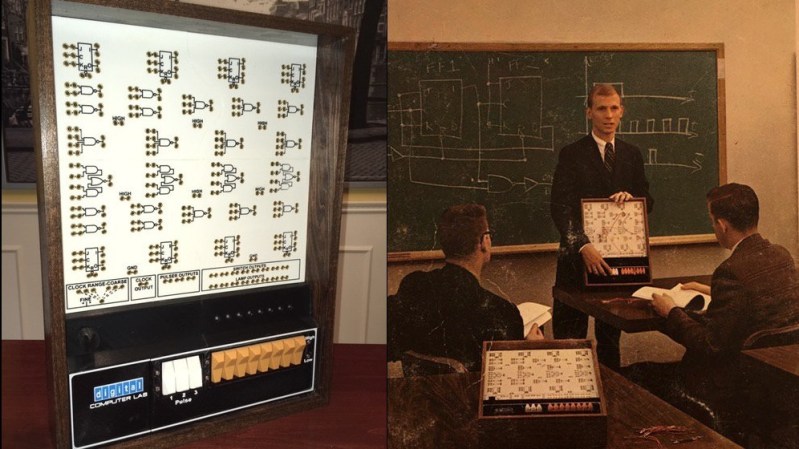If you were selling computers in the early 1960s you faced a few problems, chief among them was convincing people to buy the fantastically expensive machines. But you also needed to develop an engineering force to build and maintain said machines. And in a world where most of the electrical engineers had cut their teeth on analog circuits built with vacuum tubes, that was no easy feat.
To ease the transition and develop some talent, Digital Equipment Corporation went all out with devices like the DEC H-500 Computer Lab, which retrocomputing wizard [Michael Gardi] is currently building a reproduction of. DEC’s idea was to provide a selection of logic gates, flip flops, and other elements of digital electronics that could be hooked together into more complicated circuits. We can practically see the young engineers in their white short-sleeve shirts and skinny ties laboring over the H-500 in a lab somewhere.
[Mike] is fortunate enough to have have access to an original H-500, but he wants anyone to be able to build one. His project page and the Instructables post go into great detail on how he made everything from the front panel to the banana plug jacks; almost everything in the build aside from the wood frame is custom 3D printed to mimic the original as much as possible. But the pièce de résistance is those delicious, butterscotch-colored DEC rocker switches. Taking some cues from custom switches he had previously built, he used reed switches and magnets to outfit the 3D printed rockers and make them look and feel like the originals. We can’t wait for the full PDP build.
Hats off to [Mike] for another stunning reproduction from the early years of the computer age. Be sure to check out his MiniVac 601 trainer, the Digi-Comp 1 mechanical computer, and the paperclip computer. If you’d like to pick [Mike’s] brain about this or any of his other incredible projects, he’ll be joining us for a Hack Chat in August.
Thanks to [Granzeier] for the tip!
















Thank you Dan for such a flattering write up. One clarification though, I do not in fact own an original H-500, they are way out of my price range these day. I was fortunate enough to to get some help from people who do. Thanks go out to Bob Roswell and Vincent Slyngstad.
I remember coveting this for about five microseconds, at which time I realized that I could build one out of about $5 worth of parts from B&F Enterprises. It was those DEC rocker switches that were the hook, since they were the same ones used on the PDP-10.
Pretty good job, but BLUE LEDs??? The original used incandescents, so I would be okay with yellow…
The LEDs are actually white shining through translucent PLA diffusers, but they do look a little blue in the videos. You have me thinking though that I should have printed the diffusers with yellow PLA. I’m going to give that a try. Thanks.
I tried printing the diffusers in both yellow and in the same brown that I used for the rocker switches. The yellow doesn’t look too bad (better than the transparent IMHO), but the brown looked great after I changed the limiting resistor to about 330R.
See: https://hackaday.io/project/170232-dec-h-500-computer-lab-reproduction/log/180026-a-better-incandescent-look
Cool!
I’ve still got an original tape of “MAKE-A-CHIP” for the ZX Spectrum. Surprising what can be done with so little. Or should I say, it’s surprising how wasteful people are with memory these days.
I’m just envisioning a grid of tri coloured LEDs, used as a display. Colours representing each gate type and interconnects. Bare minimum graphics and processing to create logic arrays.
my first job was programming on a Wang Mini computer, the main terminal had 16k I think and 5mb hard drives the size of washing machines, and 8″ floppy drives. I thought it would take forever to fill that thing up. The new computers/windows is so wasteful, video cards alone have more memory than the whole computer system did then.
At first I thought that was a single picture, with a giant front-of-the-classroom sized unit, which made those rocker switches look even more sexy than if they were regular size. Still, I appreciate the DEC styling. TTL dates from 1963, and those gates seem to map to some standard TTL chips, so that should be easy, 7400 7410 7420 7451 7473. Then you need some appropriate jacks and jumpers, maybe pay some good money for banana jack stuff. Thank goodness for ’70s style 0.1″ breadboards, I’d never have gotten my start with something so expensive.
I’ve got quite a few spare US-style light switches from replacing them with Decora over the years, and I’ve been thinking about making a big toggle switch panel by screwing them together about an inch apart. Not quite as sexy as DEC rockers or IMSAI paddles, but still should look good in an oversized front panel.
You totally nailed it 8bitwiz. You should have a quick peak at the Hackaday or Instructable links In the article to see just how close you were.
I’m still gathering the parts to build mine, but the final item looks good. I got a few people at where I work interested in seeing it when I’m done. was looking at the instructions on instructibles and noticed that the Gerber files for the PCB’s are here. I haven’t found them yet, but that will help a lot. Any help here?
The Gerber files are in the Hackaday blog https://hackaday.io/project/170232-dec-h-500-computer-lab-reproduction in the FILES section. For some reason Instructables does not allow .zip files I think.